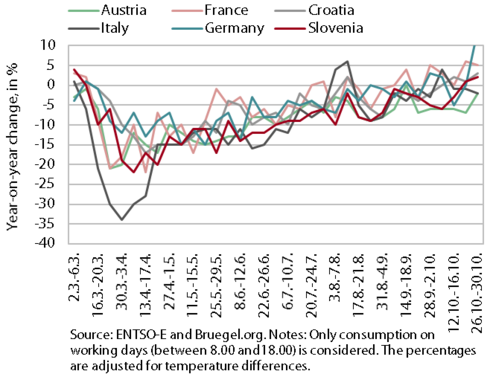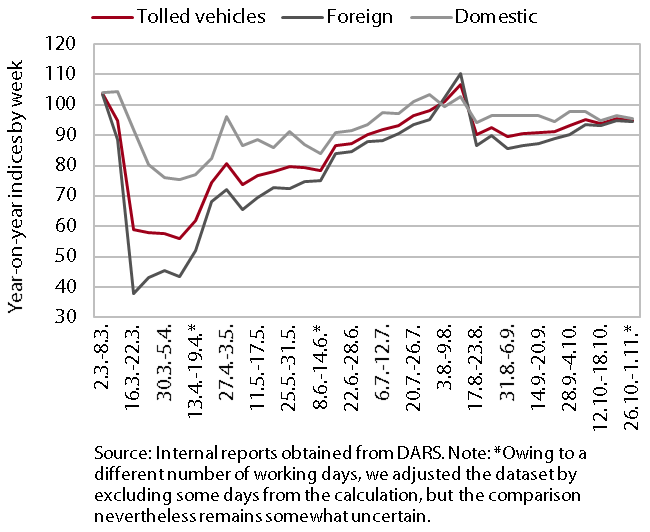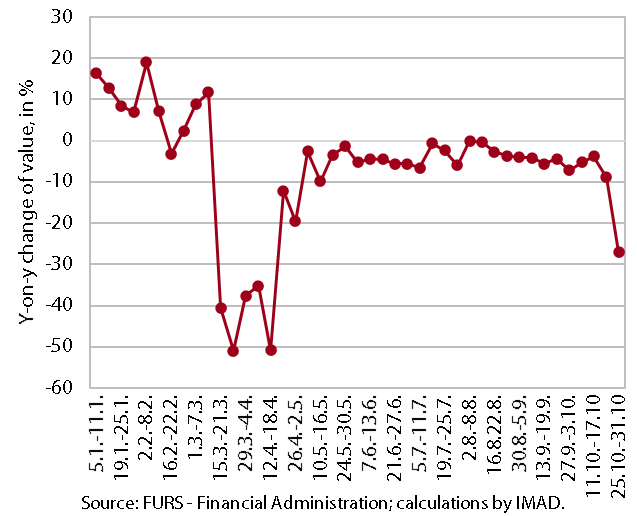Charts of the Week
Current economic trends from 2 to 6 November 2020: electricity consumption, traffic of electronically tolled vehicles and fiscal verification of invoices
Electricity consumption increased in the second half of October and slightly exceeded last year’s levels in the same period. We estimate that this time, unlike when the epidemic was declared in the spring, there were no major changes in industrial electricity consumption and that the increase in consumption could also be a consequence of higher household consumption due to remote work and schooling. Data on fiscally verified invoices indicate that the direct economic impact of the renewed increase in COVID-19 infections and the related restrictions on business operations, while considerable, may be significantly less intense than in the spring. In October, freight traffic on Slovenian motorways increased slightly, but remained lower than before the epidemic.
Electricity consumption, October 2020

According to final data for October, weekly electricity consumption exceeded last year’s level in the second half of the month. Electricity consumption was up 1%–2% year on year in the period when the epidemic was declared again. Unlike in the spring, when electricity consumption had fallen significantly with the declaration of the epidemic, this time there were no major changes in industrial consumption, which accounts for the largest share in total electricity consumption. We also estimate that the increase in household consumption was due to remote work and schooling. Among main trading partners, Austria recorded the sharpest year-on-year decline in weekly electricity consumption in the second half of October (around 5%), followed by Italy (around 2%). In others, consumption exceeded last year’s level, in Germany by 7%, in France by around 6% and in Croatia by 2%.
Traffic of electronically tolled vehicles on Slovenian motorways, October 2020

Freight traffic on Slovenian motorways increased slightly in October, but remained lower than before the epidemic. After a sharp fall following the declaration of the epidemic in March, it increased markedly from mid-June to mid-August. Then it fell again and remained around 10% below the comparable last year’s level until the beginning of October, when it increased again slightly. In the week between 26 October and 1 November, it lagged 5% behind the comparable last year's level, similarly for foreign and domestic hauliers.
Fiscal verification of invoices, October 2020

Data on fiscally verified invoices indicate that the direct economic impact of the renewed increase in COVID-19 infections and the related restrictions, while considerable, could be significantly less intense than in the spring. According to data on fiscally verified invoices (fiscal cash registers), turnover in the last seven days of October was 25% lower year on year (at the end of March, the decline was more than 50%). It fell the most in gambling and betting activities, arts and entertainment activities, travel agencies and accommodation. A sharp decline was also recorded in food and beverage service activities, but it was smaller than in the spring. The markedly smaller total decline than in the spring was mainly attributable to lower turnover in retail trade and in the sale and repair of motor vehicles.
